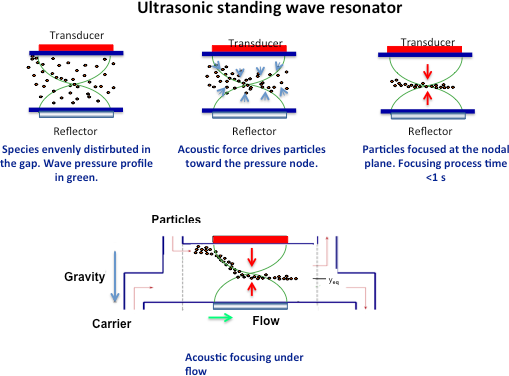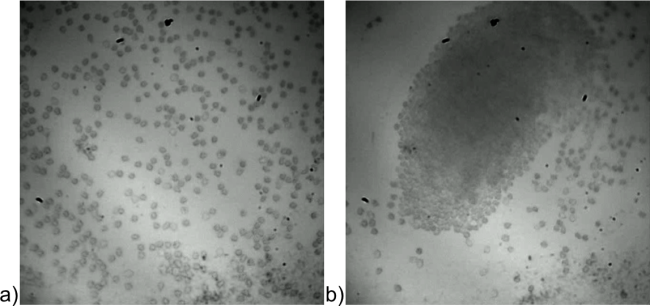Permanent members :
[\In our team we are interested in manipulating or sorting polydisperse suspensions using force fields. There are many force fields that can be used to act on suspensions, but only a few can be applied to living cells without having to use biomarkers. Among these techniques we focused our efforts during the last few years on acoustophoresis and in general on acoustofluidics.

Acoustophoresis consists in using the Acoustic Radiation Force (ARF) created when an ultrasound stationary wave is generated between the two opposite walls of a channel. Depending on the acoustic wavelength (acoustic wavelength equal to twice the channel thickness), it is indeed possible to create an acoustic pressure node at the mid-height of the channel. The ARF drives the particles or cells towards the pressure node where they can then be trapped (“acoustic levitation”) if there is no flow. The typical size of the cells that can be moved by ARF ranges from 100 nm to several tens of microns. The typical thickness of a microchannel can be a few hundreds of microns.
Acoustic Sorter
The ARF strongly depends on the physical properties of the objects (density, size, elasticity). Thus, depending on the amplitude of the sound wave, it is possible to focus some cells at the center of the channel while others will not be moved. Particles or biological cells (bacteria, red blood cells, etc) of different sizes or different acoustic properties can thus be separated, such as red blood cells and platelets under flow.
Acoustic tweezer
During our work, we also discovered that it is possible to use this principle beyond the resonance condition. We have shown that it is possible to continuously move the acoustic focusing position over the entire height of the channel by just varying the frequency of the ultrasonic wave around the resonance frequency. This discovery, published in the journal Ultrasonics in 2013, opens many routes of application since it is now possible to move the particles / objects along the height of the channel. It can be seen as an “acoustic tweezer”. These results had previously been patented by the CNRS in 2012 (world patent).

Formation of a Red Blood cells aggregate with ARF. Starting from a suspension, a large aggregate is created in less than 3 seconds.
Self-acoustophoresis
One of our findings during ultrasonic manipulation of micron-sized objects has been the auto-propulsion of metallic nano-cylinders when an ARF is applied. The propulsion by ultrasounds is called “self-acoustophoresis” (Fig) and the nano-rods behave like “nano-motors”. Originally self-propulsion was obeserved when the nano-rods were suspended in hydrogen peroxid, which is not bio-compatible and toxic for humans. We also demonstrated that self-acoustophoresis can also be achieved when nano-rods are suspended in any bio-compatible fluid. This discovery opens the way to biological applications such as drug delivery by “nano-robots” propelled directly into cancer cells for instance./]

Gold-platinum nano-rods aligned in levitation under acoustic field. Gold nanorods introduced in HeLA cells (cancer cells)
Because of the many potential applications of this technique, we also founded in 2014 a start-up (Aenitis Technologies) whose objective is to develop new devices for biophysical applications, the first one being blood cells fractionation. The company exploits a set of patents filed by M. Hoyos & J.-L. Aider as CNRS researchers during the last ten years.


